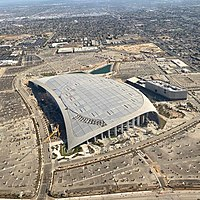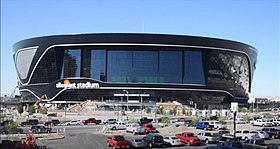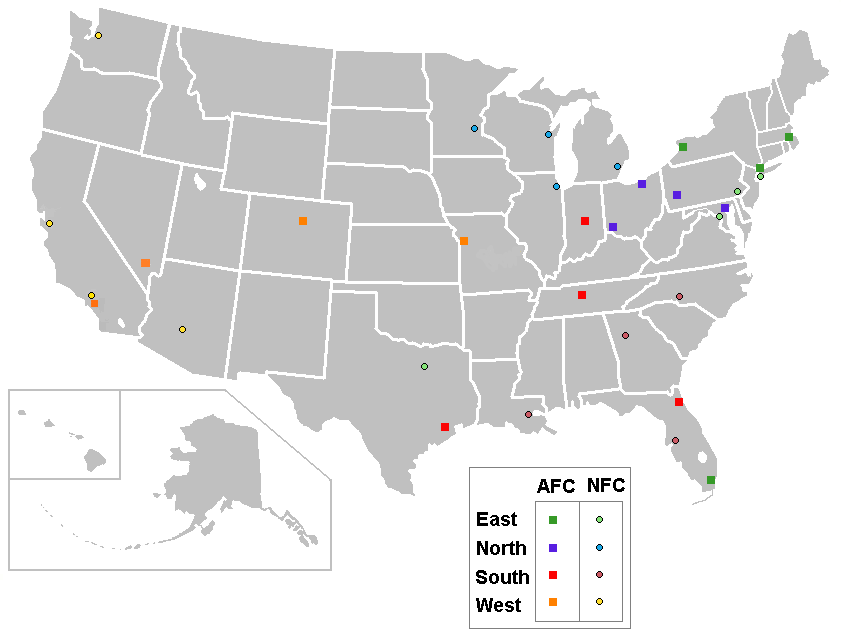NFL Stadiums in the United States
Carolinashoe.com Men's Steel Toe Boots
 List of current National Football League stadiums
List of current National Football League stadiums
Jump to navigationJump to search
 SoFi Stadium, scheduled to open in 2020. It is the home of the Los Angeles Rams and the Los Angeles Chargers
SoFi Stadium, scheduled to open in 2020. It is the home of the Los Angeles Rams and the Los Angeles Chargers Allegiant Stadium, scheduled to open in 2020. It is the home of the Las Vegas Raiders
Allegiant Stadium, scheduled to open in 2020. It is the home of the Las Vegas RaidersThis article is a list of current National Football League stadiums, sorted by capacity, their locations, their first year of usage, and home teams. Although the National Football League (NFL) has 32 teams, there are only 30 full-time NFL stadiums because the New York Giants and New York Jets share MetLife Stadium, and the Los Angeles Rams and the Los Angeles Chargers share SoFi Stadium.
The newest full-time NFL stadiums are SoFi Stadium in Inglewood, California, home of the Los Angeles Rams and the Los Angeles Chargers, and Allegiant Stadium in Las Vegas, home of the Las Vegas Raiders, which will both open for the 2020 season. Soldier Field in Chicago is the oldest, having opened in 1924.
The NFL uses several other stadiums on a regular basis in addition to the teams' designated regular home sites. In England, two London venues—Tottenham Hotspur Stadium and Wembley Stadium—are contracted to host a combined four games per season, as part of the NFL International Series which runs through 2020. Estadio Azteca in Mexico City hosted NFL International Series games in 2016, 2017, and 2019, and is under contract to host one game per season through 2021. In addition, Tom Benson Hall of Fame Stadium in Canton, Ohio, is the location of the annual exhibition Pro Football Hall of Fame Game. Since 2016, Camping World Stadium in Orlando, Florida has hosted the Pro Bowl.
The majority of current NFL stadiums have sold naming rights to corporations. As of the upcoming 2020 season, only five of the league's 30 stadiums—Arrowhead Stadium, Bills Stadium, Lambeau Field, Paul Brown Stadium, and Soldier Field—do not use a corporate-sponsored name.
Contents
- 1Stadium characteristics
- 2Legend
- 3List of current stadiums
- 4Additional stadiums
- 5Future stadiums
- 6See also
- 7Notes
- 8References
- 9External links
Stadium characteristics[edit]
Stadiums represent a considerable expense to a community, and thus their construction, use, and funding often enter the public discourse.[1] Also, given the perceived advantage a team gets to playing in its home stadium, particular attention is given in the media to the peculiarities of each stadium's environment. Climate, playing surface (either natural or artificial turf), and the type of roof all contribute to giving each team its home-field advantage.
Stadiums are either open, enclosed, or have a retractable roof. For retractable roofs, the home team determines if the roof is to be opened or closed 90 minutes before kickoff. The roof remains open unless precipitation or lightning is within the vicinity of the stadium, the temperature drops below 40 °F (4 °C), or wind gusts are greater than 40 miles per hour (64 km/h), in which case the roof operators will close the roof.[2]
Seating[edit]
With a peak capacity of over 100,000 spectators, AT&T Stadium has the highest capacity of any NFL stadium, while MetLife Stadium has the highest listed seating capacity at 82,500. The smallest stadium is Soldier Field with a capacity of 61,500.
In their normal configurations, all of the league's 30 stadiums have a seating capacity of at least 60,000 spectators; of those, a majority (17) have fewer than 70,000 seats, while eight have between 70,000 and 80,000 and five can seat 80,000 or more. In contrast to college football stadiums, the largest of which can and regularly do accommodate over 100,000 spectators, no stadium in the league currently has a listed seating capacity of more than 82,500. Teams rarely build their stadiums far beyond the 80,000 seat threshold (and even then, only in the largest markets) because of the league's blackout policy, which prohibited the televising of any NFL game within 75 miles of its home market if a game does not sell all of its non-premium seating. The policy has been suspended since 2015; from then until 2019, several teams were playing in temporary facilities with capacities far larger than a normal stadium, and in 2020, social distancing mandates prohibited teams from selling out their stadiums. In the opposite direction, the league has a firm minimum on the number of seats an NFL stadium should have; since 1971 the league has not allowed any stadium under 50,000 seats to host a full-time NFL team. In normal circumstances, all NFL stadiums are all-seaters.
Legend[edit]
List of current stadiums[edit]
Some stadiums can be expanded to fit larger crowds for other events such as concerts or conventions. Official seating capacities do not include standing room.
Map of current stadiums[edit]
 Allegiant
AllegiantStadiumArrowhead
StadiumAT&T
StadiumBank of America
StadiumBills
StadiumCenturyLink
FieldEmpower Field
at Mile HighFedEx
FieldFirstEnergy
StadiumFord
FieldGillette
StadiumHard Rock
StadiumHeinz
FieldLambeau
FieldLevi's
StadiumLincoln Financial FieldLucas Oil
Stadium
M&T Bank StadiumMercedes-Benz
StadiumMercedes-Benz
SuperdomeMetLife
StadiumNissan
StadiumNRG
StadiumPaul Brown
StadiumRaymond James
StadiumSoFi
StadiumSoldier
FieldState Farm
StadiumTIAA Bank
FieldU.S. Bank
Stadium
Additional stadiums[edit]
| Image | Stadium | Capacity | Location | Surface | Roof type | Event(s) | Opened | Ref(s) |
|---|---|---|---|---|---|---|---|---|
 | Allegiant Stadium | 65,000 | Paradise, Nevada | Grass | Fixed | Pro Bowl | 2020 | [3] |
 | Estadio Azteca | 87,523[42] | Mexico City, Mexico | Grass | Open | NFL Mexico Game | 1966 | |
 | Tom Benson Hall of Fame Stadium | 22,364 | Canton, Ohio | FieldTurf Classic HD | Open | Hall of Fame Game | 1938[nb 2] | [43] |
 | Wembley Stadium | 86,000[nb 3] | London, England | Desso GrassMaster | Partially retractable | NFL London Games | 2007 | |
 | Tottenham Hotspur Stadium | 62,062 | London, England | Artificial turf | Open | NFL London Games | 2019 | [44] |
Future stadiums[edit]
| Stadium | Capacity | Location | Surface | Roof type | Team(s) | Opening | Ref(s) |
|---|---|---|---|---|---|---|---|
| Future Buffalo Bills stadium | Buffalo, New York | Grass | Open | Buffalo Bills | |||
| Future Washington Stadium | 60,000 | Open | Washington Football Team |































